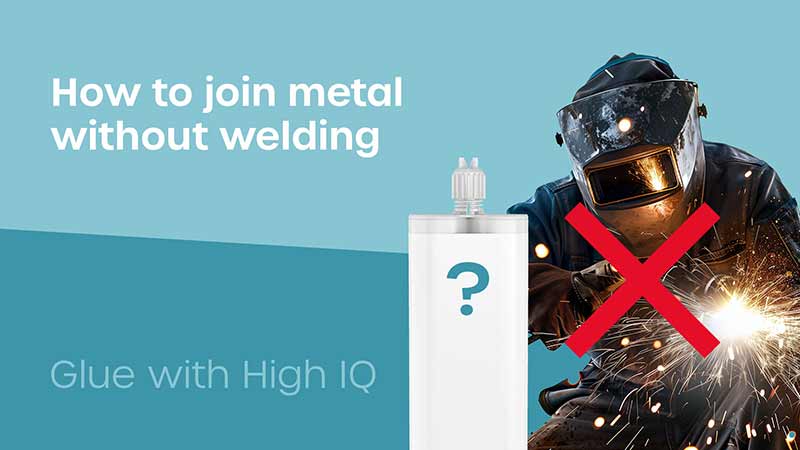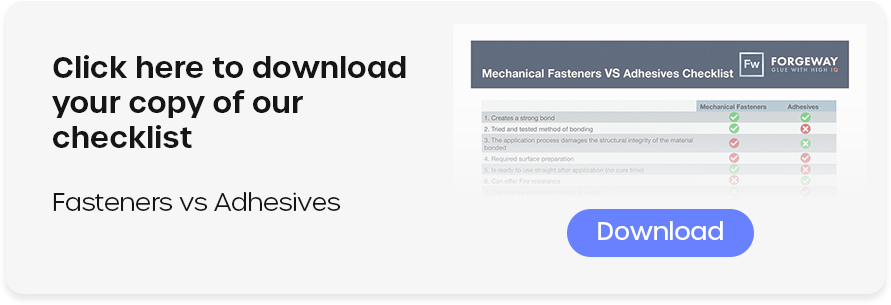Joining metal to metal without welding: Top 2 alternatives

Joining metals is never an easy task. Welding has been the conventional joining method for the past ten years or so because it is strong, very strong.
But maybe you’re facing an issue with welding. Or maybe you are struggling to find highly skilled welders. Either way, you are looking for an alternative method of joining metal to metal.
Here at Forgeway, we are adhesive specialists. We help people understand what they can and can’t do with glue.
The question around alternative joining methods to welding is a question we regularly answer.
There are several alternatives. Adhesives are one solution that we will be talking about in this article. But don’t worry, the purpose of the article isn’t to sell you our adhesive product.
By the end of the article, we want you to understand what alternatives there are to welding. We will discuss the alternatives in this article so you can decide which joining method best suits your needs.
If you would prefer to watch our video explaining this topic in more detail, you can watch Lauren discuss it below.
Why welding is a popular method of joining metal to metal
We should start by clarifying that you can also weld plastics, but this article is focused on welding metal to metal.
There are several different types of welding. The three most common are MIG, TIG, and Stick welding. These are all various types of Arc welding. I will explain why they are so popular without getting into the specifics.
 From left to right – MIG Welding, TIG Welding, and Stick Welding
From left to right – MIG Welding, TIG Welding, and Stick Welding
They are all relatively inexpensive whilst providing very durable joints that are also extremely strong.
We shouldn’t understate the strength of a weld. As a general rule of thumb, a 1-inch weld will hold up to 1 tonne of force. It is one of the most robust joining methods.

The strength coupled with the speed at which it reaches handling strength makes it seem like a no-brainer.
But there are issues with welding. In fact, you are probably experiencing them currently hence you are reading this article. We will discuss them next.
Why is welding not always the best joining method?
The most prominent issue with using welding as a joining method is resource shortage. Yes, there are other drawbacks to welding, but the greatest challenge is finding sufficiently trained welders and welding supplies.
There is a serious shortage of highly-skilled welders. We could get stuck into the reason why there is a shortage, but that’s not what this article is about.
Ultimately, if you can find a highly-skilled welder, make the most of it.
Even if you can find a highly-skilled welder, there are still things you should be aware of.
There have been recent changes to legislation around the requirements for ventilation when welding indoors.
In summary, the fumes from welding can be harmful. The HSE has introduced these regulations to try and protect the workers from these fumes.
Most of the time, manufacturers install local exhaust ventilation (LEV) systems if they want to meet these requirements.

However, not everyone wants to install these LEVs as it is a costly and time-consuming process. These LEVs aren’t always able to meet the legal requirements either.
The changing regulations and the serious shortage of highly-skilled workers are big problems. They are the main cause of the shift towards looking at other methods of joining metals.
There are other drawbacks to welding too though. Welding cannot join dissimilar materials and it creates a lot of heat. In fact, so much heat that the metal can disfigure if not welded correctly.
Global shortages have also impacted welding equipment meaning that there are shortages of welding tips.
What are alternative metal to metal joining methods?
There are two alternative joining methods to welding; mechanical fasteners and adhesives.
These two are often compared against each other. In fact, we wrote an article discussing which joining method is the better option (Spoiler alert, the answer was “it depends”).
It may seem biased coming from an adhesive specialist, but if anyone knows the drawbacks to adhesives as well as their strengths; it’s us.
There is a bit of history around this topic. We can see the trends around the use of these bonding methods on an industrial scale over the years.
In the manufacturing industry particularly, mechanical fasteners were the go-to joining method. This lasted until the late 1900s until one particular mechanical fastener rose in popularity; Rivets.

These continued to rise in popularity until welding’s benefits became more widely recognised around 2010.
Welding then went on to become the more popular method that it is today. So long as the metals weren’t dissimilar, welding would usually always be used to join them.
Currently, it seems there is another shift. The difficulties with welding discussed above are causing the manufacturing industry to look elsewhere. They either go back to using mechanical fasteners or try adhesives (if they haven’t used them before).
Mechanical fasteners

Bolts are a type of mechanical fastener
Mechanical fasteners are the method that most know will work as they will likely have used them before.
The advantages of mechanical fasteners:
- they require minimal surface preparation
- they are almost as fast as welding as they also have no cure time
- they are the only joining method that is easily reversible
The disadvantages of mechanical fasteners:
- they are prone to point loading which can cause the fixing to fail over time
- they create debris or ‘swarf’
- they are a more costly option than the other two methods
In summary, mechanical fasteners can do the job. The manufacturing industry used them for years before they used welding so they will work, but they aren’t perfect. Welding overtook their use for good reason.
Adhesives

Not everyone has used adhesives before. Particularly in the manufacturing industry. Even if the adhesives are significantly better than the existing method, the change process is always daunting.
Changing the joining method is never an easy task, we understand that.
Adhesives are an excellent option because:
- They are often the cheapest joining method
- They are the most effective method of joining for newer, more advanced materials such as carbon fibre, composites, and glass-reinforced plastic (GRP).
- They can be just as strong as welding in the right situation
Adhesives have some disadvantages though:
- They usually require more surface preparation than the other methods
- They are the only method that has a cure time
- They require knowledge on how to use them, although not as extensive as welding
So, you know that mechanical fasteners will work to join the metal. You also know that adhesives can provide an equally strong bond as welding.
If you would like to explore the ‘Mechanical Fasteners Vs Adhesives‘ debate, download our checklist which can help you determine the better option for you below.
If adhesives seem like a good welding alternative and you want to be sure that you are using the correct glue for your metal, continue reading.
Or you can take the 45-second quiz below to help you find the perfect adhesive choice for your application.
Can you use an adhesive instead of welding for metal to metal joining?
Yes, you can use adhesives instead of welding to join metal to metal. Adhesives can provide as strong a joint as welding. Although there are, of course, caveats.
If you require a reliable and durable bond (of course you do), you will need to consider the joint design.
A conventional weld will always offer a higher strength per square millimetre than adhesives.
This can mean several things if you are wanting to use an adhesive instead of welding. However, the main thing you need to do is to ensure the surface area of the joint is sufficient for the adhesive to bond effectively.
Some may know this as bond line thickness but in case you didn’t already know, now you do. Typically we recommend a bond line thickness of 1mm-2mm.
Certain joints will not provide enough surface area to bond effectively with adhesives. In these instances, you will need structural support for the joint to reach the same strength as adhesives.

So ultimately the answer is yes, you can use adhesives instead of welding. But you will need to take these considerations into account to ensure that the joint reaches sufficient strength.
If you are ever concerned about the adhesive’s strength, don’t risk it. Contact the supplier or get in touch with an expert who will be able to help you determine how you should use your glue.
What is the best joining method for me?
The answer to this question very much depends on what you are looking for in the joint. We understand you may be having issues with welding and we can probably guess why.
So if you are looking for an alternative joining solution to join metal to metal, don’t worry. There are other joining options available than just welding.
Because we are the adhesive specialists here at Forgeway, we are able to tell you what you can, and can’t, do with glue.
However, if you can find a highly skilled welder, you have the necessary extraction required, and you want a robust joining method you can trust; welding is the best option for you.
If not, you can use either use mechanical fasteners or adhesives.
Mechanical fasteners will provide a quick and easy joining method that is easy to remove if necessary. But, they may not be strong enough and are likely to weaken over time.
Adhesives offer a light and cheap method of joining metal to metal. They are also significantly safer than welding. But, they can be difficult to apply and structural support may be required.
Your situation is probably different though, and you may want the help of an expert to assess your specific situation.
If you want to read more about joint design and the correct structural support methods, chapter 6 of our Ebook will provide more information. Or you can download the entire Ebook with the link below.
Thomas is the Content Manager here at Forgeway. Thomas' job is to translate the technical jargon from the ivory tower of academia into easy-to-read content that everyone can understand. Forgeway's mission is to answer every question our customers and prospective clients ask, or are apprehensive to ask.




